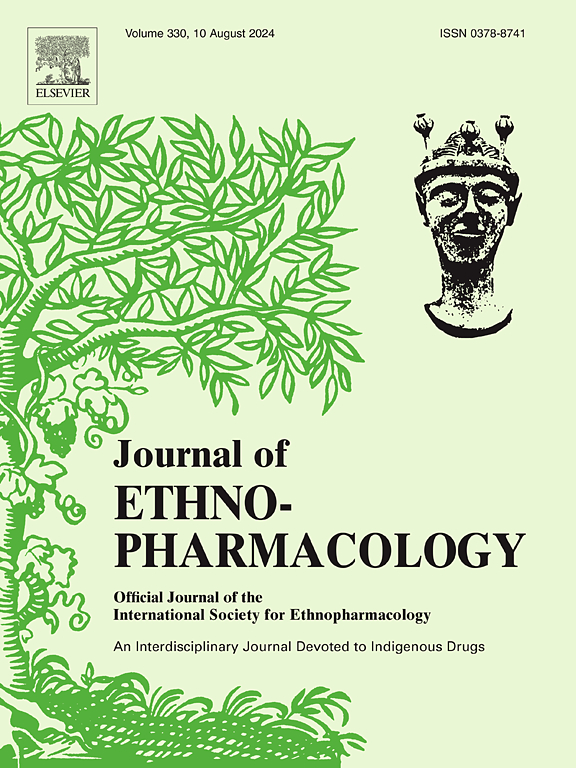鼠尾草叶提取物:化学分析及生物学研究。
IF 4.8
2区 医学
Q1 CHEMISTRY, MEDICINAL
引用次数: 0
摘要
民族药理学相关性:植物含有各种生物活性分子,可以通过预防不同疾病的发生和发展来促进人类健康,包括癌症、糖尿病、神经退行性疾病和心血管疾病。鼠尾草品种自古以来就被用于传统医学和烹饪用途。研究目的:从意大利卡拉布里亚(Calabria)种植的鼠尾草(Salvia officinalis L.)叶中提取了四种提取物,并对其进行了定性和定量表征,发现其具有较高的生物活性成分。对其生物活性进行了研究,发现其具有抗氧化、抗炎和抗癌的特性。此外,还测试了所有提取物对神经和神经退行性疾病中一些酶的潜在调节作用,如MAO-A和B, AChE和BChE。最后对提取物的安全性进行了研究。材料与方法:采用常规浸渍法和超声辅助提取法。采用超高效液相色谱法进行化学表征。通过体外、直接酶法、荧光法和细胞法进行生物学评价。结果:色谱分析表明,其具有清除活性氧、抑制NO生成和影响乳腺癌细胞活力的活性成分。此外,所有提取物都针对一些与神经和神经退行性疾病有关的酶,如MAO-A和B, AChE和BChE。此外,提取物被发现是安全的,具有低肝毒性。结论:本研究表明,传统用途广泛的鼠尾草叶提取物具有多种生物活性,可调节氧化应激和炎症,抑制乳腺癌细胞生长,阻断神经系统疾病的一些关键酶。本研究报告的低毒性和生物学特性表明,所研究的提取物在治疗某些病理状况和/或生产营养保健品方面具有很高的潜力。本文章由计算机程序翻译,如有差异,请以英文原文为准。

Salvia officinalis L. leaf extracts: Chemical analysis and biological studies
Ethnopharmacological relevance
Plants contain various bioactive molecules that may promote human health by preventing the onset and progression of different illnesses, including cancer, diabetes, neurodegenerative conditions, and cardiovascular issues. Salvia species have been employed since ancient times in traditional medicine and for culinary use.
Aim of the study
Herein, four extracts from leaves of Salvia officinalis L., cultivated in Calabria (Italy) were obtained and quali- and quantitatively characterized, finding a high presence of bioactive compounds. The extracts were investigated for their biological activities, showing interesting antioxidant, anti-inflammatory and anticancer properties. In addition, all the extracts were tested for their potential regulation of some enzymes involved in neurological and neurodegenerative diseases, as MAO-A and B, AChE and BChE. Finally, the safety of the extracts was also investigated.
Materials and methods
The extracts were obtained using conventional maceration and ultrasound-assisted extractions. The chemical characterization was achieved by the means of Ultra-High Performance Liquid Chromatography. The biological evaluation was performed by in vitro, direct enzymatic, fluorescence and cell-based assays.
Results
The chromatographic analysis indicated a high presence of bioactive compounds, which confer high ability in ROS scavenging, NO production inhibition and impacting breast cancer cells viability. In addition, all the extracts targeted some enzymes involved in neurological and neurodegenerative diseases, as MAO-A and B, AChE and BChE. Moreover, the extracts were found safe and with a low hepatotoxic toxicity.
Conclusions
The present study demonstrated that the extracts from Salvia officinalis L. leaf, traditionally used for many puproses, possess various biological activities, regulating the oxidative stress and inflammation, reducing the growth of breast cancer cells and blocking some key enzymes involved in neurological diseases. The combined low toxicity and biological features reported in this work suggest a high potential of the studied extracts for the management of some pathological conditions and/or for the achievement of nutraceutical products.
求助全文
通过发布文献求助,成功后即可免费获取论文全文。
去求助
来源期刊

Journal of ethnopharmacology
医学-全科医学与补充医学
CiteScore
10.30
自引率
5.60%
发文量
967
审稿时长
77 days
期刊介绍:
The Journal of Ethnopharmacology is dedicated to the exchange of information and understandings about people''s use of plants, fungi, animals, microorganisms and minerals and their biological and pharmacological effects based on the principles established through international conventions. Early people confronted with illness and disease, discovered a wealth of useful therapeutic agents in the plant and animal kingdoms. The empirical knowledge of these medicinal substances and their toxic potential was passed on by oral tradition and sometimes recorded in herbals and other texts on materia medica. Many valuable drugs of today (e.g., atropine, ephedrine, tubocurarine, digoxin, reserpine) came into use through the study of indigenous remedies. Chemists continue to use plant-derived drugs (e.g., morphine, taxol, physostigmine, quinidine, emetine) as prototypes in their attempts to develop more effective and less toxic medicinals.
 求助内容:
求助内容: 应助结果提醒方式:
应助结果提醒方式:


